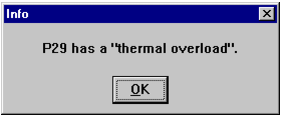
The caret character ( ^ ) signifies a special instruction in Cicode, called an escape sequence, primarily used in the formatting of text strings. Escape sequences include formatting instructions such as new line, form feed, carriage return, backspace, horizontal and vertical tab-spaces, single and double quote characters, the caret character, and hexadecimal numbers.
Strings are commonly represented in Cicode between double quote characters ( " ) known as delimiters. If you want the string to contain a double quote character itself as part of the string, you need to precede the double quote character with the caret character ( ^" ) so that Cicode doesn't interpret the double quote in the string as the delimiter indicating the end of the string. The caret character is interpreted as a special instruction, and together with the characters immediately following it, are treated as an escape sequence instruction. See the section titled Formatting Text Strings for the list of escape sequences used in Cicode.
In the following Cicode example, both of these message functions will display the following message.
Message("Info", "P29 has a ^"thermal overload^".", 0);
sCurrentAlmText = "Thermal Overload";
Message("Info", "P29 has a ^""+sCurrentAlmText+"^".", 0);
